| Srl | Item |
| 1 |
ID:
124700
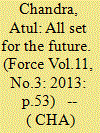

|
|
|
|
|
| Publication |
2013.
|
| Summary/Abstract |
The EADS Innovation Works site at Bangalore exists to prepare the future and explore the synergies for the group and is working on several important projects at present. Interacting with select media in Bangalore on his first visit to India after taking charge as Head of EADS Innovation Works in June this year, Sébastien Remy outlined his plans for the Bangalore centre, "We are focussing on the long term activities like the emerging technologies and solutions". He adds that the Bangalore centre is "working with Cassidian India to optimise performance of radars something that could be fully applicable to existing products. This on-going research work has resulted in the filing of a patent."
|
|
|
|
|
|
|
|
|
|
|
|
|
|
|
|
| 2 |
ID:
124670
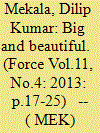

|
|
|
|
|
| Publication |
2013.
|
| Summary/Abstract |
INS Vikramaditya, the floating airfield, has an overall length of about 284 metres and a maximum beam of about 60 metres, stretching as far as three football fields put together. Standing about 20 storeys tall from keel to the highest point, this massive 44,500 tonne ship will be the biggest ship that will be operated by the Indian Navy. The ship has a total of 22 decks.
Vikramaditya in its earlier avatar with the Russian Navy as the Kiev class aircraft carrying cruiser 'Baku' was capable of operating fixed wing Vertical Takeoff and Landing (VTOL) fighters. The task of breathing life and converting the ship from a VTOL missile cruiser carrier to a short take off but arrested recovery (STOBAR) aircraft carrier involved substantial degutting, equipment removal, refit and re-equipping. The major works included modification of flight deck to include ski-jump and arrester gear; modification of bulbous bow, aft aircraft lift and ammunition lifts; modification of 1,750 out of 2,500 compartments; installation of new main boilers; installation of new and additional diesel generators; replacement of existing distilling plants; fitment of Reverse Osmosis plants, new AC plants and Refrigeration plants and installation of new sensors and equipment. "More than 80 per cent of the equipment fitted into the ship is new," said an Indian Navy officer.
Creation of the flight deck with structural modification to convert the VTOL carrier to a STOBAR carrier was apparently the most intricate and arduous. The task involved installation of Sponsons to increase the breadth at the Flight Deck and a fitment of a new 14 degree ski jump, strengthening of arresting gear area, strengthening of runway area and elongation of the aft end to generate the required length of landing strip aft of the arresting gear. In all 234 new hull sections were installed to achieve the desired shape.
|
|
|
|
|
|
|
|
|
|
|
|
|
|
|
|
| 3 |
ID:
125967
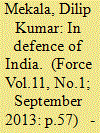

|
|
|
|
|
| Publication |
2013.
|
| Summary/Abstract |
Despite the falling rupee, which might affect defence spending for some time, Lockheed Martin remains surprisingly optimistic about defence and homeland security business in the country. Not just that, it has already started looking for potential partners from the private sector. "The economics here are not troubling us," said Susan Maraghy, regional vice president for South Asia, Corporate International Business Development, Lockheed Martin Corporation.
|
|
|
|
|
|
|
|
|
|
|
|
|
|
|
|
| 4 |
ID:
124676
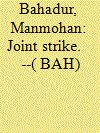

|
|
|
| 5 |
ID:
124829
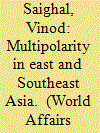

|
|
|
|
|
| Publication |
2013.
|
| Summary/Abstract |
The military build up in the Asian region is perhaps the most massive accretion of arms for any set of adversaries since the end of the Cold War. History bears witness that excessive militarization has leads to an irreversible momentum for the outbreak of hostilities. Often triggered by a minor incident, as nearly happened on India's border in early 2013. There is however potential to restore and maintain stability in the region by the coming together of like-minded countries threatened by not-so-peaceful designs of the Chinese. The key to this stability would be the perception of friendly East and Southeast Asian countries that India is in it for the long haul.
|
|
|
|
|
|
|
|
|
|
|
|
|
|
|
|
| 6 |
ID:
125986
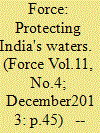

|
|
|
|
|
| Publication |
2013.
|
| Summary/Abstract |
Eurocopter's AS565 MB Panther provides a highly capable solution for planned helicopter acquisitions by the Indian Navy (IN) and Indian Coast Guard (ICG), offering a force multiplier with an excellent record that benefits from a heritage of mission-proven rotorcraft in service with military forces worldwide.
|
|
|
|
|
|
|
|
|
|
|
|
|
|
|
|
| 7 |
ID:
124701
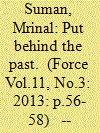

|
|
|
|
|
| Publication |
2013.
|
| Summary/Abstract |
On 18 September 2013, during his visit to India, US deputy secretary of defence Ashton B. Carter, the second highest ranking official of the Pentagon, made a momentous offer of technological cooperation to India. More significantly, he announced that the US was prepared to co-develop and co-manufacture products that could be sold internationally. It was a major policy statement that reflected a keen desire of the US to improve military ties with India. The offer took many Indian observers by surprise.
During the Cold War period, Indo-US military relations were either non-existent or lacked intensity. The US considered India to be in the Soviet camp and declined to sell any worthwhile military equipment to it. The collapse of the Soviet Union saw the end of the Cold War. Thereafter, protracted Indo-US engagement resulted in the 'Agreement on Defence Relations' in 1995.
|
|
|
|
|
|
|
|
|
|
|
|
|
|
|
|